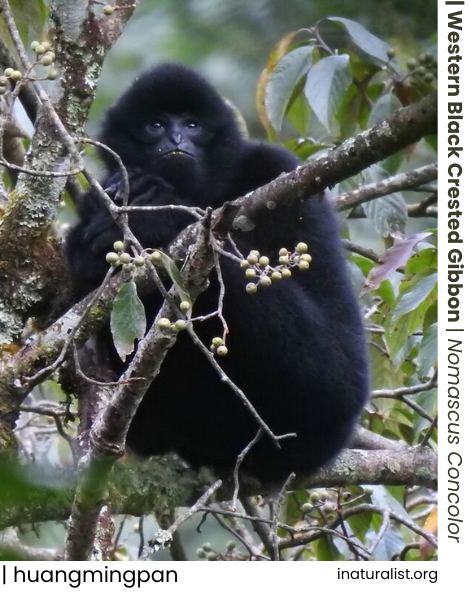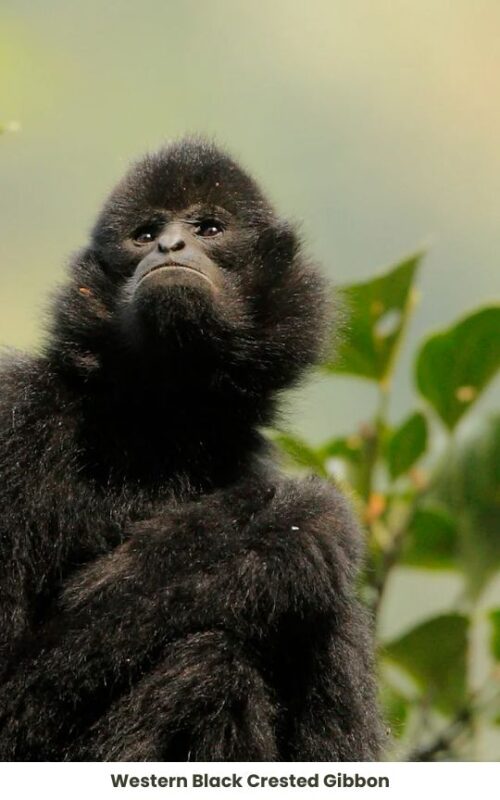Nestled within the verdant landscapes of Vietnam, the Western Black Crested Gibbon (Nomascus concolor) emerges as a captivating species that embodies the diverse tapestry of the country’s wildlife.
In this exploration, we embark on a detailed journey into the taxonomy, appearance, habitat, behavior, reproductive biology, and conservation status of this remarkable primate.

Are you looking for Wildlife Tours in Vietnam?
WANEE VIETNAM is your go-to destination for "Wildlife Tours in Vietnam", specializing in Birding, Primate Watching, Herping, Photography Tours and Educational Tours led by our expert guides.Taxonomy and Classification – Western Black Crested Gibbon:
Regnum: Animalia
Phylum: Chordata
Class: Mammalia
Ordo: Primates
Familiar: Hylobatidae
Genus: Nomascus
Species: Nomascus concolor

The Western Black Crested Gibbon, scientifically known as Nomascus Concolor, belongs to the Nomascus genus. Distinguished by its sleek black fur, the gibbons exhibit a remarkable crest of hair atop their heads. Males and females showcase subtle variations in coloration, with males often possessing a more prominent crest. Their slender bodies and long limbs equip them for a life of agility and grace as they traverse the forest canopy.
Habitat and Distribution:
The black crested gibbon inhabits tropical evergreen, semi-evergreen, deciduous forests in subtropical and mountainous areas. It generally lives in high altitudes, from 2100 to 2400 m above sea level, where most of their food resources are concentrated. In Vietnam and Laos, the species is found at lower altitudes, while in China, it has been observed as high as 2689 meters.The four subspecies are geographically separated.
The Tonkin black crested gibbon (Nomascus Concolor ) occurs in southern China (southwestern Yunnan) and northern Vietnam (Lao Cai, Yen Bai, Son La, and Lai Châu provinces), between the Black and Red Rivers. The West Yunnan black crested gibbon occurs in a small area near the Burma border, west of the Mekong, in southwestern Yunnan, southern China.
The Central Yunnan black crested gibbon occurs in a small region around the Wuliang Mountains, between the Mekong and Chuanhe rivers in west-central Yunnan. The Laotian black crested gibbon (N. c. lu ) occurs in northwestern Laos in an isolated population on the east bank of the Mekong in Laos.
Behavior and Social Structure:

The Western Black Crested Gibbons are renowned for their vocal prowess, emitting haunting calls that reverberate through the forest. Living in small family units, they exhibit a complex social structure marked by strong familial bonds. Monogamous pairs engage in cooperative behaviors, including grooming and mutual displays, strengthening their social cohesion. Their acrobatic displays in the treetops not only showcase their physical prowess but also serve as expressions of social interaction.
It has been observed that some groups consist of one adult male living with two to four females and their offspring. The group could potentially include one infant, one juvenile, one adolescent, and one sub adult. Groups have been found to be territorial, like other species of gibbons. Territories are limited by the availability of the male for territory defense. Thus, group and territory size would be limited.
Reproductive Biology:
Reproductive strategies are vital for the perpetuation of the species. Western Black Crested Gibbons engage in monogamous pairings, where courtship rituals play a crucial role in bonding. The gestation period for females is approximately seven months, culminating in the birth of a single offspring. The nurturing of the infant is a collaborative effort between both parents, emphasizing the cooperative nature of their familial structure.
Conservation Status:

The conservation status of the Western Black Crested Gibbon is a cause for concern. Classified as Endangered by the International Union for Conservation of Nature (IUCN), their population faces threats from habitat loss, illegal hunting, and the pet trade.
The biggest threats to Nomascus concolor, throughout its range, include destructive local forest use and hunting, while selective logging and agriculture encroachment are additional threats. In Lao PDR, despite the presence of local taboos on hunting gibbons in some areas, these animals are captured and killed for subsistence as well as the pet and “medicine” trades.
Why don’t you visit Vietnam on a primate discovery tour? Click here.
Conclusion:
As we unravel the intricacies of the Western Black Crested Gibbon’s taxonomy, behavior, and conservation status, a call to action echoes through the forest canopies. The future of these captivating primates lies in the hands of those committed to preserving the rich biodiversity of Vietnam. Let this exploration serve as a testament to the importance of concerted efforts in ensuring the continued existence of the Western Black Crested Gibbon, a living symbol of the country’s natural heritage.
Crocodile Trail – The Best Birding Trail in Cat Tien National Park
If you’re a birder or nature photographer planning a trip to Vietnam, few places offer [...]
Cong Troi Trail – Top 1 Dalat Plateau Birding Trail Experience
If you’re a birder or nature photographer planning a trip to Vietnam’s Central Highlands, the [...]
How to Identify the Greater Sand Plover, Tibetan Sand Plover and Siberian Sand Plover
ContentsTaxonomy and Classification – Western Black Crested Gibbon:Habitat and Distribution:Behavior and Social Structure:Reproductive Biology:Conservation Status:Conclusion:Identification [...]
Highlights of Cat Tien National Park Reptiles and Amphibian Endemics
Spanning over 71,350 hectares of tropical forests, grasslands, and wetlands, Cat Tien National Park is [...]
Highlights of Cat Tien National Park Mammals in a World Biosphere Reserve
In addition to reptiles and birds, Cat Tien National Park is also rich in mammals, [...]
Kontum Plateau Endemic and Highlight bird
Kontum Plateau Endemic And Highlight Bird species like Chestnut-eared Laughingthrush and top birding routes while [...]